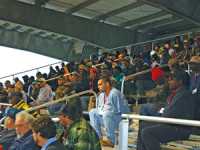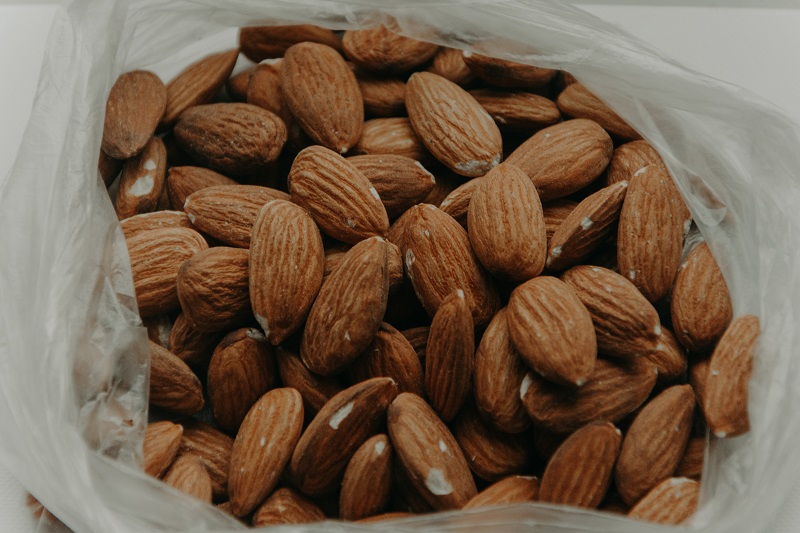Fighting Together

Beautiful blue skies on a clear, cool morning helped make a welcoming opening day for the 2007 Indian River Citrus Seminar — presented by Florida Grower magazine, the University of Florida (UF), and the Indian River Citrus League (IRCL) and hosted at the St. Lucie County Fairgrounds in Ft. Pierce.
Day two, however, was an entirely different story. And although the cold, wet, blustery conditions on Jan. 25 made attendees duck for cover, it did not deter the more than 1100 citrus growers, grove workers, researchers, and allied members from enjoying an event filled with information, entertainment, demonstrations, and training.
“From an information standpoint, this was one of the best seminars ever,” says Dr. Brian Boman, an event coordinator and statewide best management practices director for UF’s Institute of Food and Agricultural Sciences (UF/IFAS). “Judging by the turnout, growers found it useful, too.”
Starting With A Celebration
This year’s event began with the IRCL annual banquet, which was held at the Pelican Inn Yacht Club in Ft. Pierce. Dozens of growers, family members, and industry personnel filled the banquet hall and were treated to a presentation by Jack Fox, deputy director of external relations at NASA’s John F. Kennedy Space Center. Fox spoke about NASA’s struggles and triumphs, and how the agency weathered tough times to eventually succeed in its goals.
“Florida citrus is no different,” he said during the presentation. “Your industry — like ours — is filled with the smartest and most resilient people in the country.
“You have weathered adversity before, and I know you will do it again.”
After the presentation, which included dramatic photos of various space missions, IRCL Executive Vice President Doug Bournique presented the inaugural Legends of the River Award to Phil Gates Sr. and J. Richard Graves (posthumously).
“These men served the citrus industry and the Indian River region with superb dedication for decades,” said Bournique. “And, now we honor them by making them the first-ever Legends of the River.”
Gates’ family was on hand to congratulate the grower, who exchanged humorous barbs with Bournique.
“I remember him when he first started,” said Gates. “I told his girlfriend she was too good for him.”
Door prizes were also given away, with winners taking home such gifts as brand new fishing rods and reels, a fishing trip, golf outings, and dinner certificates.
The Big Picture
With the evening’s festivities over and a night’s rest had by all, the first morning was bustling with excitement, as nearly 400 attendees joined the mass of pre-registered event-goers to learn about the latest production trends and techniques, and also to understand the current state of the industry at large.
The educational sessions on the first day began with an overview of where the state’s citrus industry is — including seminars on the viability of the fresh-fruit industry, packinghouse inspections and surveys, changes to citrus nursery regulations, and growers developing their own nurseries.
Nate Jameson of Brite Leaf Nursery gave a sobering synopsis of the state of the citrus nursery community.
“Eight of the state’s largest nurseries were completely destroyed,” he said. “The total amount of trees lost was nearly 5.5 million trees.”
Jameson went on to say that estimates of young tree requirements from growers are about 9 million trees, and growers will need to be in greenhouses as soon as possible to be able to meet any orders by January 2008.
Up Close With Canker
Perhaps the biggest topic of discussion — and rightfully so — was canker. Many of the more than 30 seminars were about canker spread, control methods, emerging technology, rootstocks, and research. Nearly the entire first day was dedicated to presentations about the subject, and growers packed the seminar hall to hear the latest on control techniques.
Greg McCollum, a scientist with the USDA Agricultural Research Service in Ft. Pierce gave a presentation on varietal experiences with canker.
“In short, we do not know as much as we need to about resistance,” he said. “But, we do know that grapefruit is one of the most highly susceptible varieties in production.”
McCollum said that research is ongoing to develop more resistant rootstocks, which may include working with rootstocks of varieties that are known to be highly resistant to the disease. Some of those parents are Murraya paniculata, Severinia buxifolia, and Glycosmis pentaphylla.
McCollum also said leaf age was a factor in the development of canker lesions. Ongoing research to determine the cause may yield some important discoveries.
“Mature leaves consistently and significantly developed fewer lesions than younger ones,” he said. “Using an in-vitro technique to investigate the leaf response to canker infection has proven to be feasible.”
A Look At Leafminer
Another focus of several of the sessions was leafminer control. Two of UF’s most prominent entomologists spoke on insect control from several angles. Dr. Michael Rogers discussed how growers managed leafminer this past season, and what they can do to protect their grove during the summer.
“There was a high population of leafminer this season,” he said. “This can be attributed to several factors: weather, pesticide choices, and cultural practices.”
Rogers said soil-applied imidacloprid application is the best option for preventing leafminer damage on non-bearing trees, and applications should be made 10 to 14 days prior to anticipated flush.
“Soil-applied imidacloprid on non-fruit bearing trees just prior to summer flush and again just prior to the fall flush will provide control of leafminer during the peak time for insect damage,” he said. “It will also provide control of Asian citrus psyllid during these times as well.”
On bearing trees, Rogers said growers must rely on foliar applications of the product.
“In general, there have never been any soil-applied systemic organophosphate or carbamate insecticides shown to provide effective control of leafminer damage,” he said. “Preventing damage on bearing trees for canker management much more difficult.”
Dr. Phil Stansly’s presentation on biological controls for leafminer and the Asian citrus psyllid focused on combining conventional pest control measures with biological ones.
“Let the biological controls work on your mature trees,” he said. “They are less susceptible and less likely to get to greening, the spring flush largely escapes damage, and the trees are less attractive to psyllids. Young trees are more likely to serve as sources of infection for either disease, so chemical control methods should be the primary focus.”
Greening Gaining Attention
While canker is the disease du jour, greening was also covered extensively on the second day of the event. On this day, event coordinators tapped the vast experience of the growing community to provide some insight into control measures. Growers from some of the state’s largest groves gave presentations on their disease management strategies — including Raphael Terra from Southern Gardens Citrus, Peter McClure from Evans Properties, Randy Sexton from Sexton Groves, and Pete Spyke from Arapaho Citrus.
“Start with a delimiting survey to determine if you have greening, and where it is in your grove,” said Terra.
“If resources are limited, start with the outer grove boundaries, along canals and roads, and along edges of grove blocks.
A panel discussion about greening and canker control methods concluded the disease session, with growers, researchers, and allied members each approaching the topic from several different perspectives.
“The bottom line is we all need to work together,” said Jack Hebb, a show coordinator and UF/IFAS Extension agent. “There’s no way we can let the industry fail if we all work toward the same goal.”
The final session of the two-day seminar focused on growing crops to be used as alternative fuel sources. Topics included crops best suited for ethanol production, economics of producing those crops, and long-term prospects for energy crops.
“While we may be several years away from being truly able to feasibly produce and sell these crops, it’s never too early to start thinking about it,” said Brad Krohn from U.S. Envirofuels.
Working At Training
The highly popular grove-worker training was once again well attended, with more than 600 grove workers filing into the fairgrounds arena.
And, while the weather was cold, windy, and rainy, it did not deter from presenters offering valuable information designed to help grove workers obtain certification.
Two concurrent presentations for both the Spanish-speaking workers and the English-speaking ones centered mostly around safety and disease identification. St. Lucie County Fire Department personnel were on hand to demonstrate proper extinguisher techniques, spill containment and clean-up, and basic first-aid tips.
“Grove workers are exposed to the elements every day,” said Puddin Race, a fire department representative. “It’s important for them to learn how to protect themselves and help others who may experience injury.”
The goal of the disease-identification portion of the training was not to make the grove workers experts, said Darren Cole, a best management practices implementation specialist for UF/IFAS, but instead to make them more prepared to spot potential infections and report them to a supervisor.
“Grove workers are the growers’ first line of defense in disease identification,” he said. “If we make them proficient, then the grower can better manage his grove.”
To aid the instructors, a canker and greening identification contest was introduced to help growers quickly identify infected leaves on trees. Cole constructed 40 trees using PVC, plastic branches, and leaf-shaped photos of canker and greening lesions, and graded grove workers on their proficiency of identifying diseased trees.
“Having the workers look through the trees is the best way to train them,” Cole said. “You can look at it on paper all you want, but until you can spot an infected leaf on a tree, you never really get a feel for what it looks like against other leaves.”
Even though the weather did not cooperate on day two, the seminar provided valuable information that cannot be obtained anywhere else.
“There is no other event that combines all of the elements of grove operations,” said Gene Thurston of Heritage Groves in Titusville. “This event truly is the crown jewel of the citrus industry.”









